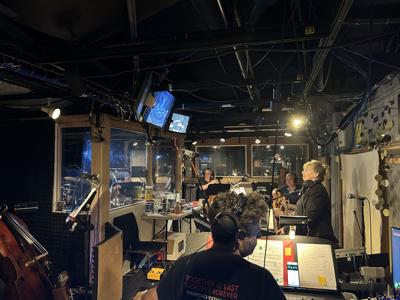STRATFORD — If you sit among the woodwind players in the orchestra of “Dirty Rotten Scoundrels,” now playing at the Stratford Festival’s Avon Theatre, you’re afforded an ant’s-eye perspective up into the auditorium that’s quite unlike any other.Ìý
Above the lip of the orchestra pit sits the first row of the audience, so close you can almost touch them. But beyond their heads, you can also view the balcony in this cavernous, proscenium-arch venue. And when Michael Walton’s lighting designs reflect off the stage at just the right angle and just the right brightness, they cast a brilliant glow that emanates into the crowd, illuminating the faces of the 1,100 people seated in the audience.Ìý
In these rare instances, you can see everything: a man turning to his partner with an expansive grin; a woman gripping her daughter’s arm and laughing so hard that both of them are shaking in their seats; and an older couple in the front row with eyes darting back and forth across the stage. For the instrumentalists performing in Stratford’s rambunctious musical comedy, it’s catching small moments such as these that keep the show fresh and invigorating, day in and day out.
At a pair of recent matinees, I sat in with both the orchestras of “Scoundrels” and “Annie” (the latter running at the Festival Theatre) to get a glimpse of what it takes to bring to life the scores of those two shows.Ìý
Some of the musicians have been playing at Stratford for decades. A few are Broadway veterans. Others are marking their festival debuts. But many told me that each performance offers something new — whether its hearing one of their colleagues onstage delivering a joke in a slightly different way or eyeing some of those reactions from the audience.Ìý
“That’s what’s exciting about live theatre,” Laura Burton, the conductor and music director of “Annie,” told me in an interview. “We’re not reinventing the material each night, but we’re listening, staying in the moment and different things happen. Every show, it’s like, where is it going to take us now?”Ìý
The orchestras are the beating heart of both musical productions. They fill out the sound of each show, lending “Scoundrels” its big, brassy texture and “Annie” its distinctive, hummable melodies.Ìý
But their contributions are often taken for granted. It’s not uncommon, in fact, for some audiences to believe that the actors onstage are singing to a pre-recorded orchestral track. “My daughter came to the show the other day,” said Burton, “and when I walked out onstage during the bows with my baton, some people around her remarked: ‘What’s that woman doing with the stick?’ She had to tell them that I was the conductor and there are 15 musicians playing in a live orchestra.”
Even for a theatre critic, the orchestra is easy to overlook. It wasn’t until I sat in behind the scenes, with a copy of the music for “Annie” and “Scoundrels” in front of me, that I realized how much material is underscored with music.Ìý
In “Scoundrels,” melodies from early numbers are reintroduced later on as musical motifs, meant to accompany certain characters or themes. It’s much the same in “Annie,” with the iconic tunes from “Tomorrow” and “Maybe” woven into the score throughout the show whenever its titular red-headed orphan is onstage.Ìý
In a way, however, it should be a compliment that these small details go unnoticed to audiences sitting in the theatre; the best orchestrations and underscoring, after all, should set the mood of the story, but never in a manner that obtrudes on the telling of it.Ìý
Franklin Brasz, who’s the director of music for the festival and is also the conductor of “Scoundrels,” described his role as such: “The live energy of the orchestra has to support the story that’s happening onstage,” he said. “And for me, my job is to connect those two, while also balancing the energy of the crowd.”
While Burton and Brasz have similar roles as the conductors of Stratford’s two musical productions this season, their jobs, in practice,ÌýlookÌývastly different. And that can be chalked up to the distinct set-ups of theÌý“Annie” and “Scoundrels” ensembles at the festival.
Whereas the orchestra pit at the Avon is like one you might find at a traditional Broadway theatre, located beneath the stage, the musicians playing at Stratford’s Festival Theatre are situated high above it. The orchestra loft, as the space is called, is located behind the upstage wall, on the same level as the theatre’s balcony.Ìý
Even with 15 musicians, the loft is surprisingly spacious, unlike the Avon’s tight pit. Musicians playing louder instruments, like brass and percussion, are seated in semi-enclosed booths, meant to temper the volumes. Burton, meanwhile, sits in the centre of the orchestra loft.
The baton she wields at the end of the show, when she takes her bow, is more of a prop than anything else. Because Burton both leads the orchestra and plays the keys, she typically only conducts using her left hand, reserving her right for the keys.Ìý
In front of her is an array of screens. With all that technology, she could be mistaken at first glance for an air traffic controller at Pearson airport. (She even has a joystick to control the views of one of the cameras, pointed toward the stage.)
While Brasz stands on a podium in the Avon’s orchestra pit and has a perfect view of the stage, Burton relies on those monitors to help her co-ordinate with the performers. There’s also a camera pointed at Burton, so the “Annie” actors can see her. (These conductor monitors are located inside the Festival Theatre’s two vomitoria, exits under a tier of sloped seats on the main level, out of sight of the audience.)
The orchestra loft is original to the Festival Theatre, constructed in 1957 and meant to replace the original tent venue that occupied the site. By moving the musicians above the stage, lead designer Tanya Moiseiwitsch was able to bring the first row of seats closer to the stage, making the theatre feel more intimate.Ìý
Another benefit of this design: because the “Annie” musicians are hidden from the audience, they can be a bit more relaxed during the show. Most of them have never had the opportunity to see the production from the auditorium, but they know the show by heart. Throughout, they’ll playfully mouth along to the dialogue, at times standing up to dramatically deliver lines to their colleagues across the loft.
It’s all in good humour. And all never known to most audiences. “We have fun together,” Burton said with a chuckle.































To join the conversation set a first and last name in your user profile.
Sign in or register for free to join the Conversation